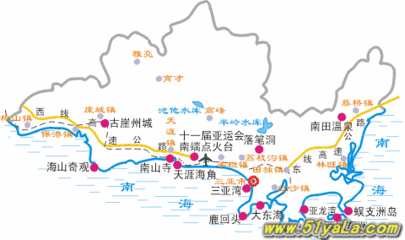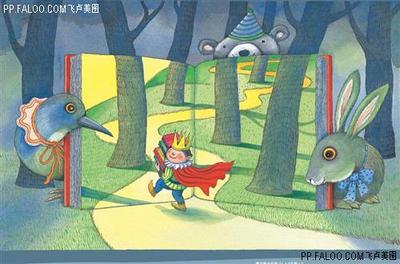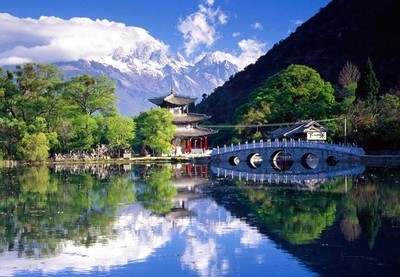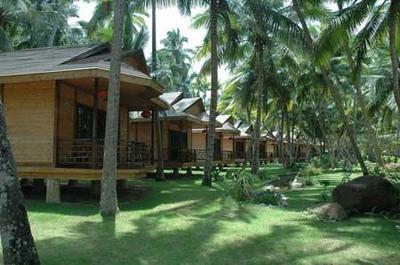Zhangjiajie National Forest Park was established by the StateCouncil in 1982 as the first National Forest Park of China. It waslisted into the World Heritage Directory by UNESCO in 1992, and in2004, Zhangjiajie was listed as a UNESCO Global Geopark. It isamong the first scenery spots that were recognized as the China’sClass AAAAA Scenery Spots in 2007. Two years later, it was awardedas the National Civilized Scenic Tourism Area.
Zhangjiajie National Forest Park is known for its unique cliffmountains, deep valleys and the greenery woods. The splendidsceneries crown the park as “three thousand peaks, and eighthundred miles of clean water”, thus it is praised as the “expandedbonsai, and the shrinked heaven.” It is also famous for abundantanimal and plant resources. Its forest coverage rate reaches to98%. An extraordinary biological treasure and natural oxygen bar,it is entitled as the “Nature Museum” and “Nature BotanicalGarden”. Animals and plants breed and grow with the peaks andwaters together, forming a perfect natural ecological system in thepark.
Zhangjiajie is in the subtropical climate zone. The mountainsand valleys and the lush forests form there a unique small forestclimate. As an ideal summer resort, the average annual temperaturein the Park is 12.8℃, and the average maximum temperature in thesummer is 16.8℃. The Park has currently developed four scenic areasincluding Huangshizhai, Yaozizhai, Golden Whip Brook andYuanjiajie, and six tour lines involving 468 viewing spots(platforms).
Huangshizhai (Huangshi Villiage)
Huangshizhai is the largest viewing platform of Zhangjiajie. Atan elevation of 1300 m, the platform can provide an overallpanorama of the Park. A common saying goes that: “it is no avail ofyou trip to Zhangjiajie, unless you come to the summit ofHuangshizhai.” There’s a tale about ZhangLiang (250-186 B.C.), afamous officer of the Han Dynasty. It’s said that Zhang Liangpracticed Taoism here and met with a mishap, and was rescued byHuangshi Taoist, who became his master later. Thus this place wasnamed after the Taoist. In the ancient times, many hermits livedhere to avoid wars and chaos. In the Ming Dynasty (1368-1644), QingPing Temple was built over the summit by monks. In the republic ofChina (1911-1949), it was occupied by the mountain bandits, andnone of the official troop’s attacks to conquer it succeeded. Thishelped to spread the fame of Huangshizhai to a further and widerextend. There are various concentrate spots along the Huangshizhaitour line, among them, the Treasure Case of Heavenly Books, theMagic Sea-suppressing Needle, the Southern Pillar of Heaven, theFront Garden, and the Golden Tortoise Watching the Sea, etc.Sunrise is another splendid view in Huangshizhai. Tourists canstart from the front gate to climb to Huangshizhai, and it takesnearly 40 minutes to the summit; or they can take the ropeway whichcosts eight minutes to reach the summit. The Yaozizhai stands justfacing Huangshizhai, with numerous peaks rising as forests. Thereare over one hundred scenery spots such as Flyover, Rock SurgeTower, Eagle Beak, Fairy Cave, Spears Rock, Pointing Mountains andWaters and so on. There’s no ropeway now, but it is full ofinterests of wildness. It is an ideal place for camping.
Golden Whip Brook
It is named after its representative attraction Golden Whip Rock.The canyon stretches seven kilometers from Laomo Bay to Wateraround Four Gates. Rock columns and peaks stand along the banks;the stream runs smoothly among them, laces together pools andwaterfalls. Ancient trees and flowers as well as the rare fowls andstrange animals grow and flourish together, forming an extremelybeautiful and elegant ecological environment. Many famous ChineseTV series and movies including “Journey to the West” were filmedhere. It is known as “the most beautiful canyons in the world”. Themain scenic spots in this area include Greeting Rock, Golden WhipRock, Purple Weed Pond, Thousands of Miles’ Meeting and WaterAround Four Gates, etc.
Nature Reserve of Mountain Tianzi
Mountain Tianzi is located at the northwest ofWulinyuan, forming a triangle with Zhangjiajie Park and Suo XiValley. The altitude of the highest point in this area reaches to1500m. It is the remarkable representative of Zhangjiajielandforms, with fully developed mesa, stone pillars, stone walls,stone peaks and stalagmites with elegancy. It was named after XiangWang Tianzi (Xiang Dakun), the hero of Tujia people who led themfought against the feudal central government in the Ming Dynasty inHong Wu years (1368-1398). There are over hundreds of natureviewing platforms, two thousand stone peaks and various streams andwaterfalls, among them, the Cloud Sea, stone peaks, snow in thewinter and sun in the glow are the most magnificent. By overlookingthe Mountain Tianzi, one can get a panoramic view of all the cliffpeaks which are like a powerful army. The main scenic spots ofMountain Tianzi include Peaks of Royal Writing Brush, West Sea,Tianzi Pavilion, Shen Tan Wang, the Grand Stage, Fairy’s Bridge,General’s Rock and God's Force Rally etc. Tourists can take ropewayto the summit of Mountain Tianzi, or climb from the South Gate. Itis one of the best tourist routes combining multiple functions ofscientific research, nature tourism and adventure tourism.
Yuanjiajie Scenic Area
Yuanjiajie Scenic Area is located at the Northwest of theZhangjiajie Forest Park. It was named after a clan with “Yuan” astheir family name. It covers a total area of 1200 hectares, andthus is commonly named as “forty-eight Li (one Li equals to halfkilometer)” Yuanjiajie. The sceneries in this area are known forits steepness and wonderful views. The air path set over the 3500m’s steep cliff connects many wonderful sights together, includingthe Back Garden, breathtaking Mihun Stage, Magic Turtle AskingHeaven, Five Women Go on an Expedition and the First Bridge underthe Sun, and thus forms one of the most wonderful and uniquepicture scroll in Zhangjiajie.
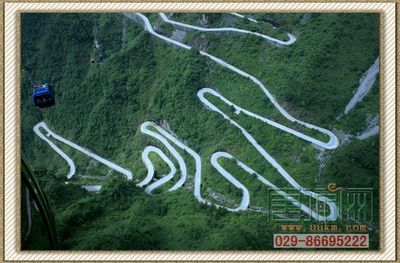
Baofeng Lake
The core scenic area of Baofeng Lake covers the whole lake surfacewhich is 2.5 kilometers in length, with a width of 200m to 1000m,and an average depth of 72m. It is the only scenic area with thewater as its scenes in the area of Wulingyuan World NaturalHeritage. Baofeng Lake is located among the mountains, receivingnatural waters all over the mountains. The water is pure and clean,free of pollution, thus it is awarded as “Holy Lake”. Around thelake stand dozens of cliff and steep sandstone mountains. If oneboats to the center of the lake, one can feast one’s eyes with thereflection of tress and peaks over the mirror-like lake surfacethat forms a splendid and wonderful landscape painting with charmand artistic conception. There are over twenty scenic spotsincluding One-line-sky, Plank Road over the Clouds, Yingwozhai, andSouth Sea and so on. It is especially famous for Baofeng Waterfallwhich falls from a height of over one hundred meters and hangs downthe mountain as a white curtain, as sound as the thunders. It wastaken as the natural performance set of Zhangjiajie InternationalFestival of Forest Protection and appeared for several times onCCTV and Hunan TV, which made it one of the ideal places forvisitors home and abroad. At present, it is the show place of “Soulof Wulin-TIMA God Song”.
Huanglong Cave (Yellow Dragon Cave)
Huanglong Cave covers an area of 20 hectares. It contains fourlayers with the total vertical height of more than one hundredmeters. There are one cave, two rivers, three waterfalls, fourpools, thirteen halls, forty-six verandas, and numerousStalagmites, stone columns, stone curtains, stone flowers and stonewaterfalls in it. The most amazing stalactites are the MagicSea-suppressing Needle and the Dragon King’s Throne. The height ofthe Magic Sea-suppressing Needle is 19.2m and reaches up to theroof of the cave, and its diameter is 10cm. The whole body of theNeedle is transparent. In 1998, it was insured for RMB10million.
The Second National Class AAAAA Scenery Spot in Zhangjiajie-Mount Tianman
Tourists can ascend on the top of the Mount Tianman by takingthe touring ropeway, and experience the excitement of flying overthe clouds. They can feast their eyes with the panoramic viewing ofZhangjiajie, and experience the proud and freedom of standing atthe highest peak. They can also take the smaller ropeway from thetop of the peak to the Cherry Bay, flying over the trees andenjoying the natural garden in the air. The Mount Tianmen Templeshall take the tourists close to the Buddhism and experience thesolemn of the Temple which has witnessed thousands years’ time. Fortourists who like challenge and excitement, the west tourist routeof Ghost Plank Road where they can scream heartily is a goodchoice. Lingxiao Platform (Platform over the Sky) is the placewhere the tourists can enjoy city scenery and the magnificentlandscape. When they get to the Middle station of the ropeway, theycan transfer to the sightseeing bus to experience the unique roadwith 99 turnings. The following destination is Tianmen Cave wherethe tourists can experience the unique heritage of the nature. Thenthey can take the sightseeing bus back to the Middle Station of theRopeway and take the ropeway to return to the city.
Main Scenic Spots:
Rainbow-Ropeway over the Clouds On Sep.6, 2005, Mount TianmenRopeway, the longest passenger ropeway over high mountains in theworld started operation. It also marked the formal open of MountTianmen National Forest Park. The length of Mount Tianmen Ropewayreaches to 7455m, with a latitudinal level distance of 1279mbetween the Upper and Middle Station, and its maximum gradientreaches to 38 degree. It is rare both home and abroad. It startsfrom the Lower Station located at the northern side of themountain, ascends along the peak. There are hundreds meters ofgreen lands under the ropeway, and if one looks toward to thesouth, the Tianmen Cave is waiting there, hanging over the sky.
Winding Road to the Heaven The Road to the Sky climbs up to thetop of the mountain, winding and bending along. It connects theTianmen Cave which is known as “the Door to eh Heaven”, thus it isnamed as “Road to the Heaven”. The total length of the road is11km, stretching between the latitudinal level distances from 200mto 1100m. 99 turnings are a real task and test for one’s drivingskills. Both sides of the road are deep valleys and cliffs. Bendingpoints with 180 degree’s angle follows one by one. The road lookslike a castle or the Great Wall floating over the clouds if it islooked up, while it appears as a romantic ribbon and a curve ifoverlooked.
Passing Through the Tianmen (Heaven’s Gate)Tianmen Cave (Heaven’s Gate Cave) locates at the cliff of 1264m inheight. It is 131.5m in the height and 60m in the depth. Thenarrowest point at the gate is 28.3m. In December 1999, worldaerobatics masters flied over the cave for the first time, whichattracted the whole world’s attention to Mount Tianmen. In March2006, Russia-27 heavy fighters and heroes from Russian Air Forcewrote another wonder over the sky of Mount Tianmen.
Mount Tianmen Temple
The temple was built in the Tang Dynasty (618-907). It wasoriginally built at the east side near the Holy Pool (Ling Quan),and called as “Holy Pool Temple” (Lingquan Temple). It declined dueto the reason of being out of repair. In the Jin Dynasty (265-420),a hermit named Zhou Piao lived here. Till the Song Synasty, a monknamed as Sijue begged alms and pooled money to rebuild a templenear the Dan Ding Zao peak at the west part of the top of the MountChisong, and named it as Songliang Temple. In the Ming Dynasty(1368-1644), a Mount Tianmen Temple was built at the Nanyan Mount,two Li at the east part of the Songliang Temple. The towers of thetemple still stand among the ancient trees, elegant and quiet, yetthe temple has been long abandoned. In 2006, a new Mount TianmenTemple was built near the original location of Mount TianmenTemple. It is close to the Cherry Bay, and covers an area of over10,000squre meters. It was built in the architectural style of theQing Dynasty(1644-1911), elegant and splendid, consisting buildingsincluding Bell and Drum Tower, Heaven King’s Hall, the Great Hall,Guanyin Pavilion and Depository, etc
Sceneries in Different Seasons
The winter still lingers, but the mountains have been coveredwith green trees full of spring air. The spring in this area hasplenty of rainfalls, thus it is the best season to visit MountTianmen and experience the wonderful sights of the clouds. MountTianmen is cool and fresh in the summer, the temperature in themountain is comparatively lower for 10 ℃ than that of down the feetof mountain, which makes it one of the best summer resorts. In theautumn, the temperature in Mount Tianmen is warm and comfortable,with yellow leaves and colorful flowers, and natural fruits such askiwi berries, litchi chinensis, and chestnuts and so on. In thewinter, Mount Tianmen is more beautiful than a northern kingdom.Mount Tianmen in a sunny day after snow is even more attractivethan any time. The blue sky, white snow and the shinning branchesof the trees in the sunlight; all these natural beauties help tobuild the Mount Tianmen a heaven in the legend.
Garden in the Air The forest at the top of the Mount Tianmen isthe primeval forest, in which grow many rare species, among them,the Davidia involucrata, incense trees, dyeriana, Dayong Carpinusand Mount Tianmen azalea. Davidia involucrate is called as “Doveflowers” by the local people; Rare it is, it is regarded as the“Panda of the plants”; yet the Davidia involucrata group thatcontains more than one hundred strains growing over an altitudeover 1500m are even rarer all over the world. Asa natural community with more than 530 species of wide plants,Mount Tianmen deserves the name of Garden in the Air. Besides,Mount Tianmen is full of wide fruits, in January there is “Wine-icefruit”, in February there’s “Bang Milk berry”;strawberry follows inthe March, and in April, it comes the loquat, and then comes thecherry in May. Peaches are ripe in June, and pear in July; InAugust, carambola is ready and in September, Chestnut and wildlitchi become ripe. In October, Laba melon is eaten; and when thewinter comes in November, there’s lilac persimmon, and in December,a local berry called “Jiu Bing Liang” (Reinforcements’ Brain Berry)are ready for eat.
Ghost Valley Plank Road
Ghost Plank Road is located in the wonderland of fairy-seeking. Itis hanged over the cliffs over the Ghost Valley Cave, and so it isnamed after the cave. The altitude of the plank road is over 1400m,which ranks it to the most difficult plank road built in China. Itstotal length is 1600 m. Standing on the plank road, one can see thebirds flying below. The broad view on the plank road can be vividlyexpressed by a line from a Chinese ancient poem, “Reach the top ofthe mountain, and all mountains are held in a single glance”. Itshall become a wonderful memory that one can never forget.
In 2007, the famous French Spiderman broke the myth, andsuccessfully climbed over the Tianmen Cave bare-handed. Thebeautiful flower of courage and braveness blossomed over thelife-and-death cliff, and Tianmen Cave, even since that moment, hasbecome the birthplace of miracles.
The Third Asia Cup Rock Climbing Competition was held on November5, 2007. Four items of male and female difficulty and speed wereset. The artificial rock wall, 15m in height and 14m in width, wasset on the famous scenic area Mount Tianmen whose latitude is over1300 m. Players from more than one dozen countries and regionsparticipated in the competition, including those who came fromSouth Korea, Japan, Indonesia, Malaysia, Singapore, Philippines,Mongolia, Kazakhstan, China and Hongkong, Macao, China Taipei andso on.
In 2001, Huang Yongyu, the world famous master of painting andcalligraphy and essayist splashed ink and painted a picture ofMount Tianmen with its magic, spectacular and elegant sceneries. Hewrote down the 435 characters inscriptions in a spontaneous yetfree and smooth style, expressed all his attachments, praise andwishes towards hishometown.
In 1997, Li Na, the Chinese famous singer, visited the undevelopedMount Tianmen, and lived there for several months in a cabin builton the top of the mountain. During her stay, she fully embraced thegrace of the Buddha in the Mount Tianmen, and determined to leavethe mortal world. She became a Buddhist nun in Wutai Mountain withthe monastic name of “Shi Chang Sheng”. She is living in the UnitedStates now, yet her heart still goes to Mount Tianmen. She promisedthat when the Mount Tianmen Temple is built, she will come back tovisit this place of her “Conditioning Cause”.
 爱华网
爱华网